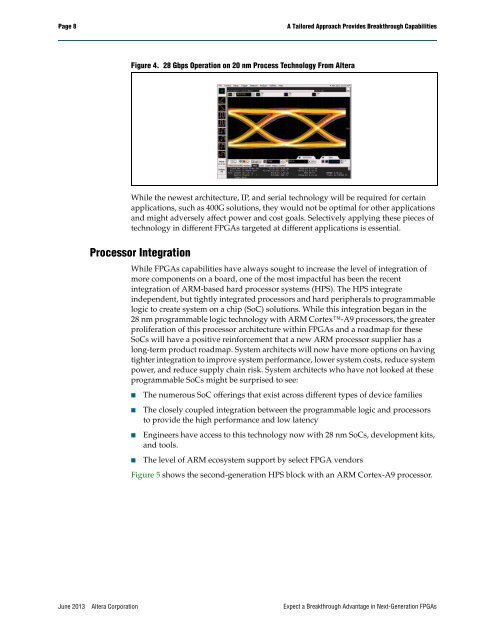Expect a Breakthrough Advantage in Next-Generation FPGAs - Altera
Expect a Breakthrough Advantage in Next-Generation FPGAs - Altera
Expect a Breakthrough Advantage in Next-Generation FPGAs - Altera
You also want an ePaper? Increase the reach of your titles
YUMPU automatically turns print PDFs into web optimized ePapers that Google loves.
Page 8<br />
A Tailored Approach Provides <strong>Breakthrough</strong> Capabilities<br />
Figure 4. 28 Gbps Operation on 20 nm Process Technology From <strong>Altera</strong><br />
While the newest architecture, IP, and serial technology will be required for certa<strong>in</strong><br />
applications, such as 400G solutions, they would not be optimal for other applications<br />
and might adversely affect power and cost goals. Selectively apply<strong>in</strong>g these pieces of<br />
technology <strong>in</strong> different <strong>FPGAs</strong> targeted at different applications is essential.<br />
Processor Integration<br />
While <strong>FPGAs</strong> capabilities have always sought to <strong>in</strong>crease the level of <strong>in</strong>tegration of<br />
more components on a board, one of the most impactful has been the recent<br />
<strong>in</strong>tegration of ARM-based hard processor systems (HPS). The HPS <strong>in</strong>tegrate<br />
<strong>in</strong>dependent, but tightly <strong>in</strong>tegrated processors and hard peripherals to programmable<br />
logic to create system on a chip (SoC) solutions. While this <strong>in</strong>tegration began <strong>in</strong> the<br />
28 nm programmable logic technology with ARM Cortex-A9 processors, the greater<br />
proliferation of this processor architecture with<strong>in</strong> <strong>FPGAs</strong> and a roadmap for these<br />
SoCs will have a positive re<strong>in</strong>forcement that a new ARM processor supplier has a<br />
long-term product roadmap. System architects will now have more options on hav<strong>in</strong>g<br />
tighter <strong>in</strong>tegration to improve system performance, lower system costs, reduce system<br />
power, and reduce supply cha<strong>in</strong> risk. System architects who have not looked at these<br />
programmable SoCs might be surprised to see:<br />
■<br />
■<br />
■<br />
■<br />
The numerous SoC offer<strong>in</strong>gs that exist across different types of device families<br />
The closely coupled <strong>in</strong>tegration between the programmable logic and processors<br />
to provide the high performance and low latency<br />
Eng<strong>in</strong>eers have access to this technology now with 28 nm SoCs, development kits,<br />
and tools.<br />
The level of ARM ecosystem support by select FPGA vendors<br />
Figure 5 shows the second-generation HPS block with an ARM Cortex-A9 processor.<br />
June 2013 <strong>Altera</strong> Corporation <strong>Expect</strong> a <strong>Breakthrough</strong> <strong>Advantage</strong> <strong>in</strong> <strong>Next</strong>-<strong>Generation</strong> <strong>FPGAs</strong>
















